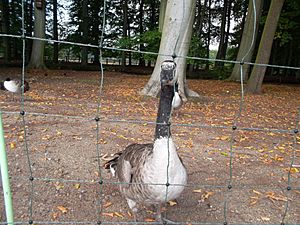Giant Canada goose facts for kids
Quick facts for kids Branta canadensis maxima |
|
|---|---|
 |
|
| A giant Canada goose at the Cottbus Zoo in Germany | |
| Scientific classification |
|
| Kingdom: | Animalia |
| Phylum: | Chordata |
| Class: | Aves |
| Order: | Anseriformes |
| Family: | Anatidae |
| Genus: | Branta |
| Species: | |
| Subspecies: |
B. c. maxima
|
| Trinomial name | |
| Branta canadensis maxima (Delacour, 1951)
|
|
The giant Canada goose (Branta canadensis maxima) is a special type, or subspecies, of Canada goose. It's the biggest one! These large birds can weigh up to 5 kilograms (about 11 pounds). You can find them living in the middle parts of North America. What's really interesting is that these geese were once thought to be completely gone, or extinct, but luckily, they were found again!
What Does It Look Like?
It can be tricky to tell the giant Canada goose apart from another type called the Moffitt's Canada goose. But there are some clues!
- Voice: Giant geese have a deeper, lower call than Moffitt's geese.
- Beak Size: Their beak is larger compared to their body size.
- Neck Markings: The black color on their neck starts much higher up than on other Canada goose types.
- Cheek Patch: The white patch on their cheek is very big. It reaches all the way down to their lower beak.
- Belly Color: Their underbelly is very light in color, almost pale.
- Forehead: Sometimes, they have white on their forehead and eyebrows. But this isn't always a sure sign, as Moffitt's geese can sometimes have it too.
How It Made a Comeback
In the 1950s, people believed the giant Canada goose had completely disappeared from the world. This means they were declared extinct.
But then, something amazing happened! In 1962, a small group of these geese was found in Rochester, Minnesota, by some biologists. This discovery was a huge surprise and a big step towards bringing them back.
Since then, the number of giant Canada geese has been growing. You can now often see them in parks and cities. It's also thought that many of the Canada geese living in Europe today came from these giant geese, along with another common type. This shows how successful their recovery has been!

